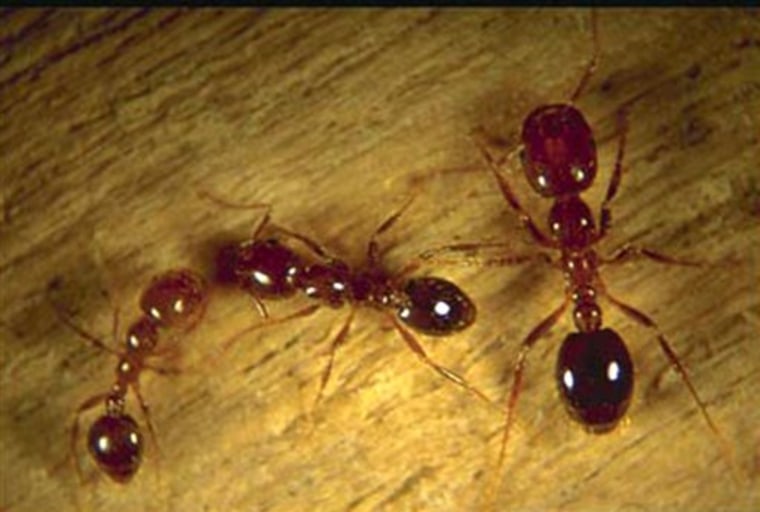LUBBOCK, Texas — Imported red fire ants have plagued farmers, ranchers and others for decades. Now the reviled pests are facing a bug of their own.
Researchers have pinpointed a naturally occurring virus that kills the ants, which arrived in the U.S. in the 1930s and now cause $6 billion in damage annually nationwide, including about $1.2 billion in Texas.
The virus caught the attention of U.S. Department of Agriculture researchers in Florida in 2002. The agency is now seeking commercial partners to develop the virus into a pesticide to control fire ants.
The virus was found in about 20 percent of fire ant fields, where it appears to cause the slow death of infected colonies.
"Certainly, we are excited about it," said Bob Vander Meer, the leader of the USDA research team in Gainesville, Fla. "I think the virus has great potential. No question about it."
Humans vulnerable
The massive fire ant colonies destroy crops, damage farm and electrical equipment and hasten soil erosion. Humans and livestock are particularly vulnerable to the insect's stinging attacks.
With no natural predators to keep them in check, fire ants have spread across the U.S., where their numbers are now 10 times greater than in their native South America. They thrive in open sunny areas such as cropland, pastures, and urban lawns, and they like moisture.
"Sustained control is what we're trying to achieve," said Steve Valles, an entomologist in the Gainesville research lab. "Eradication is not going to happen."
Fire ants have been detected in 13 states, covering 320 million acres, and are spreading northward. The pest has been found as far north as Virginia and along parts of the California coastline.
In the laboratory, the virus, SINV-1, has proven to be self-sustaining and transmissible. Once introduced, it can eliminate a colony within three months.
That's why researchers believe the virus has potential as a viable biopesticide to control fire ants, known to scientists as Solenopsis invicta.
Virus as a tool
Although it occurs naturally in fire ants, the virus needs a stressor before it becomes deadly and begins replicating within a colony, Valles said.
Integrating the virus into ant baits could offer a tool to the pest-control industry, agricultural producers and harvesters, consumers and others for whom fire ants are a persistent problem.
The virus isn't alone in the fight against the fire ant. In South America, they have dozens of natural enemies. But researchers don't know whether those predators could be introduced here.
Among them is the small phorid fly, which seeks out fire ants and lays its eggs on them. The eggs hatch into tiny maggots that bore into the heads of their host and feed on its brains.
"The problem is we really don't know how effective these phorid flies are going to be in North America," Merchant said.
Relief in Texas
Some Texans may have thought the fire ant problem was improving. Drought conditions across much of the state in recent years have only driven them deeper under ground.
"One thing you can thank the dry weather for is it keeps the fire ants down," said Mike Merchant, an extension entomologist in the cooperative's Dallas office.
This year, wet conditions have returned and that will increase pests' visibility.
"I think those fire ants are waking up," said Bart Drees, an entomologist with the Texas Cooperative Extension in College Station.
The fire ant isn't all bad. As omnivores, they eat just about anything and can reduce tick populations in pastures and yards. Also, cotton and sugarcane growers see them as helpful. The ants munch on boll weevils, caterpillars and sugarcane borers.
"But on balance they're an ecological disaster," Merchant said. "The good that they do is far outweighed by the negative."
